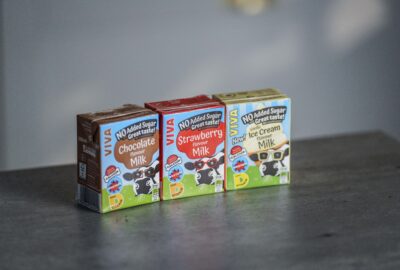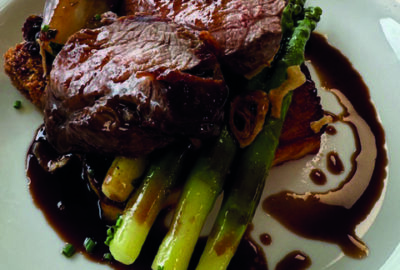The food we consume has a back story, it was grown, reared, caught and transported before making its way onto our plates. The journey our food undertakes has increasingly been in the spotlight as consumers become more aware of what they are eating, how it impacts the environment and how both workers and animals are treated. As a result, operators are now fielding questions regarding where their ingredients were grown, whether it is free range or sustainably sourced, how far it has travelled and whether or not it is organic.
In this month’s Melting Pot, we are featuring advice on how to develop menus around the changing of the seasons from caterers, chefs and restaurateurs who have based their reputation on locally sourced, seasonal menus with provenance.
Matthew Whitfield, Head Chef, The Montagu Arms
“Using local produce means that the quality of our food at The Montagu Arms and our ethical standards are aligned, as when sourcing ingredients, I like to be able to visit local farms and see how animals are reared and in what environment crops are grown. Locally sourced produce also has less transit time and therefore food is fresher and richer in taste, as you are serving it in its prime. Two of our favourite dishes include Wild Hampshire Mallard with Glazed Quince, Rose Hip and a Swede Hotpot, with quince and rose hips picked from the hotel kitchen garden, as well as Chalk Stream Trout which uses rainbow trout sourced from the River Test alongside Hampshire watercress from Alresford.”
Sofian Msetfi, Executive Chef, Ormer Mayfair
“The menus I create at Ormer Mayfair are highly seasonal and usually put two or three key ingredients in the spotlight. I wouldn’t say this is a challenge, I would say it is an opportunity to celebrate the best of British produce and make it sing beautifully on a plate. We are lucky to have locally-grown ingredients on our doorstep and it would be a shame not to make the most out of them.
It’s important to build relationships and to work closely with suppliers who know the quality of produce we are after. All our fish and seafood, for dishes such as the cured Cornish mackerel with sesame, kombu and spiced nage, is supplied by Flying Fish who work with Cornish fishermen and provide sustainably-caught, seasonal seafood so our guests can enjoy the best and freshest ingredients on their plates.”
Chris Harrod, Chef Patron, The Whitebrook Restaurant
“From the day we launched, our rural location has given us access to unrivalled hyper-local produce from those foraged in hedgerows and estuaries to those from unique suppliers of rare breeds, native animals and local vegetables. We’ve become renowned for sourcing 80% of produce from a 12 mile radius, customers come from all over the country as there are dishes on our menu that you would find nowhere else in the world, for example; Wye Valley Asparagus with Maritime Pine, Hogweed, Hedgerow Pickings and Tintern Mead Sauce or Day Plaice in Jack by the Edge with Jersey Royals, Nettles, Brown Shrimp, Hop Shoots and Buckhorn Plantain.”
Ryan & Liam Simpson-Trotman, Chef Owners, Orwells Restaurant
“For us, developing a seasonal menu is not a challenge because it’s the way we have always cooked – sustainably. It’s why our menu is never the same week on week. It’s driven by what’s available as locally as possible. Of course, some seasons are easier – currently over 70% of our fruit and veg comes from our allotment and many ingredients in dishes like our Mill Lane kohlrabi with tomato, rosti potato, salsa verde, girolle mushrooms and leek are travelling just a few metres. Seasonality is about having excellent supplier relationships and dialogue as we need to know exactly what is coming up and when so that we can adjust the menu accordingly, not the other way round resulting a compromise on food miles.”
Stuart Collins, Chef-Patron, Docket No.33
“Working with the seasons is exciting! Using ingredients at their prime is the most enjoyable way of working with food and we make the most of each ingredient for as long as it’s at its best. As soon as one season ends, there is something else coming into its prime, so there is always something to look forward to. On average our menus change once a month, although they can also change along with the availability of ingredients.
We always try to prioritise local over provenance. However, local doesn’t always mean the best quality or supply of all ingredients, so we have to look a little further afield. For example, being in Shropshire, we are landlocked and so don’t have ‘local’ fish and shellfish for dishes such as our south coast crab or chalk stream trout, so we look for the best quality that we can source from around the UK and showcase the provenance over the locality.”
Matthew Isaacs, Director, My Emissions
“The majority of food emissions come from farming, and transportation generally represents less than 10% of a food’s carbon footprint. In some cases locally-grown ingredients can even have a higher carbon footprint than imported ingredients, for example tomatoes grown locally but in a heated greenhouse.It’s therefore just as, if not more, important to think about the ingredients you are using, rather than just where it’s coming from. Sourcing seasonally-grown ingredients (and adapting your menus to match this) is a great way to improve your menu’s carbon footprint and give you a sustainability story you can explain to your customers.”
Graham Noonam-Chatham, Executive Chef, Down Hall
The challenge of seasonal menus is in the last days of winter when there is really very little around. In Summer and Autumn there really is an abundance of produce and we change things up as often as we can to keep the menus fresh and exciting. If the kitchen garden suddenly has a glut of a particular item we will use it in different ways including preserving for those dark Winter days. For instance, we have made a delicious green tomato and gooseberry jam which is currently served alongside grilled mackerel and pickled fennel.
We work with local farms for both fruit, veg and livestock. It gives me a lot of pleasure to support local businesses, I feel it really does translate to a better dining experience.


